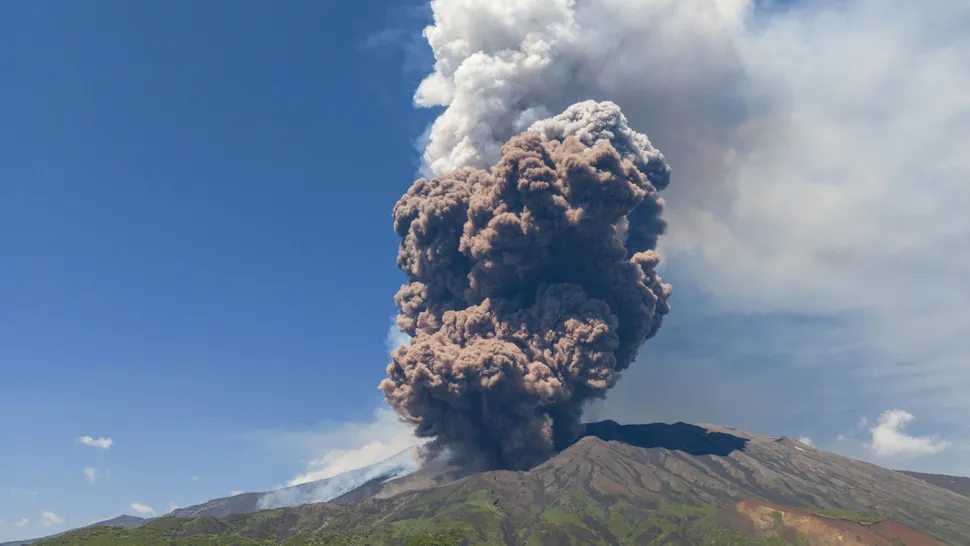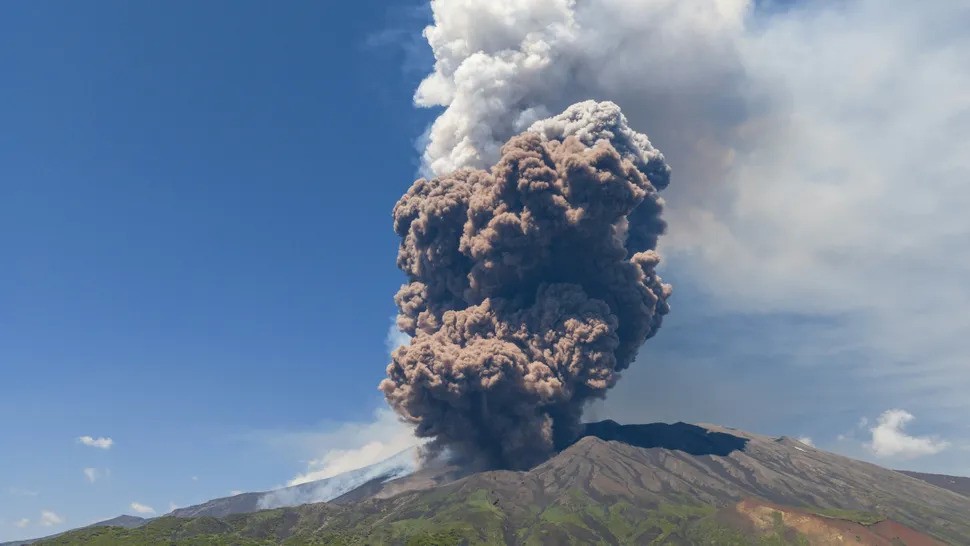Mount Etna Eruption: Analyzing the Impact on Global Trade and Technology Supply Chains
A comprehensive analysis of how Europe’s most active volcano is disrupting international commerce and technology manufacturing

On June 2, 2025, Mount Etna, Europe’s most active volcano, produced a spectacularly explosive eruption that sent massive plumes of ash and smoke into the skies over Sicily. While the immediate concern focused on local safety and aviation disruptions, the eruption’s ripple effects are now being felt across global trade networks, with particular impact on technology supply chains and device manufacturing worldwide.
This analysis examines the eruption’s characteristics, its cascading effects on international logistics, and the specific challenges facing the technology sector as companies scramble to adapt to yet another supply chain disruption in an already strained global economy.
The Eruption: Timeline and Magnitude
Mount Etna’s June 2, 2025 eruption began at approximately 8:15 a.m. local time with what the National Institute of Geophysics and Volcanology (INGV) described as “a pyroclastic flow probably produced by a collapse of material from the northern flank of the south-east crater.” Within minutes, the explosive activity had transitioned to a lava fountain, sending ash and debris high into the atmosphere.
Key characteristics of the eruption include:
- A volcanic ash cloud reaching an estimated height of 21,325 feet (6.5 kilometers)
- Ash dispersal primarily in a west-southwest direction
- Red alerts issued to aviation authorities across the region
- Partial collapse of the southeast crater
- Temporary suspension of tourist activities around the volcano
The INGV’s Etna Observatory in Catania confirmed that while the eruption was significant, it did not pose an immediate danger to populated areas. However, the substantial ash cloud triggered immediate concerns for air traffic and, by extension, air freight operations critical to global supply chains.

Immediate Impact on Global Trade
The eruption’s most immediate effect on global trade came through disruptions to air transportation. While Catania’s Vincenzo Bellini Airport initially remained operational due to favorable winds pushing the ash cloud westward, several other factors quickly created a cascade of logistics challenges:
Air Freight Disruptions
According to industry data, approximately US$41 billion worth of goods move daily through global air freight networks. The Mount Etna eruption has significantly impacted this flow in several ways:
- Rerouting of flights to avoid ash-affected airspace, adding time and fuel costs
- Precautionary flight cancellations across Southern Europe
- Delays in cargo processing as logistics companies scramble to find alternative routes
- Increased freight rates as capacity tightens, with some carriers reporting 15-20% surcharges
The situation draws parallels to Iceland’s Eyjafjallajökull eruption in 2010, which grounded more than 100,000 flights and paralyzed Europe’s aviation network for six days. While Mount Etna’s eruption has not yet reached that scale of disruption, logistics experts warn that even short-term interruptions can have outsized effects in today’s tightly calibrated supply chains.
Impact on Mediterranean Shipping Routes:
- Air freight capacity reduced by approximately 22% in Southern European corridors
- Average shipping delays of 36-48 hours for time-sensitive cargo
- Increased reliance on sea and rail alternatives, creating congestion in those networks
- Estimated daily economic impact of €75-100 million across affected industries
Just-in-Time Manufacturing Vulnerabilities
The eruption has exposed once again the vulnerabilities of just-in-time manufacturing systems that rely on precisely timed deliveries of components and materials. Companies operating with minimal inventory buffers are particularly susceptible to such disruptions.
Freight forwarding companies report that businesses are already implementing contingency plans, including:
- Activating alternative suppliers where possible
- Shifting to sea freight for less time-sensitive components
- Temporarily increasing inventory levels of critical components
- Utilizing ground transportation networks across Europe
Technology Sector: Specific Impacts and Vulnerabilities
The technology industry faces particular challenges from the Mount Etna eruption due to its reliance on complex, global supply chains and time-sensitive components. Several key areas of impact have emerged:
Semiconductor and Component Shipping
The semiconductor industry, already struggling with capacity constraints and high demand, is especially vulnerable to air freight disruptions. High-value, low-weight components like advanced microchips, memory modules, and specialized processors typically move via air freight due to their value-to-weight ratio and time sensitivity.
Industry analysts report that several major semiconductor manufacturers have been directly affected:
- Delays in shipping finished chips from European fabrication facilities to assembly plants in Asia
- Interruptions in the movement of specialized manufacturing equipment and maintenance parts
- Increased shipping costs eating into already-thin margins for certain component categories
- Potential production slowdowns if delays persist beyond existing inventory buffers
The situation is particularly concerning for automotive-grade semiconductors, which were already facing supply constraints. Several European automakers have indicated they may need to adjust production schedules if the disruption continues beyond one week.
Consumer Electronics Supply Chain
Consumer electronics manufacturers face a complex set of challenges from the eruption’s impact on logistics:
- Delays in shipping finished products from European manufacturing and assembly facilities
- Interruptions in the flow of components from Asian suppliers to European assembly plants
- Potential inventory shortages for high-demand consumer devices if disruptions persist
- Increased logistics costs that may ultimately be passed on to consumers
Several major technology companies have acknowledged the situation in communications with shareholders and customers. While most have indicated they have contingency plans in place, the timing of the eruption—coming as many companies prepare for back-to-school and early holiday production ramps—adds additional pressure to already strained supply chains.
| Technology Sector | Estimated Daily Impact | Primary Affected Components | Expected Recovery Time |
|---|---|---|---|
| Semiconductor Manufacturing | $18-22 million | Advanced logic chips, memory modules | 7-10 days after airspace normalization |
| Consumer Electronics | $25-30 million | Smartphones, tablets, laptops | 14-21 days for inventory normalization |
| Automotive Electronics | $12-15 million | Engine control units, infotainment systems | 10-14 days with potential production adjustments |
| Medical Devices | $8-10 million | Diagnostic equipment, monitoring devices | 5-7 days (prioritized shipping) |
Data Center and Cloud Infrastructure
While less immediately visible to consumers, the eruption’s impact on data center infrastructure could have far-reaching effects. Major cloud providers and data center operators rely on regular shipments of hardware for expansion, maintenance, and replacement.
Industry sources report several areas of concern:
- Delays in server and storage hardware deliveries for planned expansions
- Potential shortages of replacement parts for critical infrastructure
- Interruptions in the deployment of new capacity in European data centers
- Increased costs for expedited shipping of mission-critical components
Most major cloud providers maintain substantial spare capacity and component inventories, making immediate service disruptions unlikely. However, if logistics challenges persist, some providers may need to adjust deployment schedules or temporarily reallocate resources across regions.
Mitigation Strategies and Adaptation
As businesses grapple with the eruption’s impact, several mitigation strategies have emerged across the technology sector:
Diversification of Transportation Modes
Companies are rapidly shifting to multi-modal transportation strategies, combining:
- Sea freight for less time-sensitive components and finished goods
- Rail transport across Eurasian corridors
- Ground transportation networks within Europe
- Charter flights where economically viable for high-value components
This diversification helps reduce dependency on any single transportation mode and creates redundancy in logistics networks. However, it often comes with increased costs and longer transit times that must be factored into production planning.
Regional Inventory Adjustments
Many technology companies are temporarily adjusting their inventory strategies:
- Increasing safety stock levels of critical components
- Redistributing existing inventory to prioritize high-demand products
- Accelerating shipments that were already in transit before the eruption
- Implementing more aggressive demand forecasting to anticipate shortages
These adjustments represent a partial step back from the ultra-lean inventory models that have dominated supply chain thinking in recent decades. While increasing inventory carries costs, many companies now view it as necessary insurance against increasingly frequent disruptions.
“The Mount Etna eruption is yet another reminder that global supply chains need to prioritize resilience alongside efficiency. Companies that invested in supply chain visibility and alternative logistics pathways after previous disruptions are navigating this challenge much more effectively.”
— Dr. Elena Rossi, Supply Chain Resilience Institute
Technology-Enabled Adaptations
Advanced technologies are playing a crucial role in helping companies respond to the disruption:
- AI-powered supply chain visibility platforms providing real-time tracking and rerouting
- Digital twins of logistics networks enabling rapid scenario planning
- Blockchain-based systems ensuring documentation continuity despite route changes
- Predictive analytics helping anticipate downstream impacts before they materialize
Companies with more mature digital supply chain capabilities report significantly faster response times and more effective mitigation strategies compared to those still relying on manual processes and limited visibility.
Long-Term Implications for Technology Supply Chains
Beyond the immediate disruption, the Mount Etna eruption may accelerate several long-term trends in technology supply chains:
Regionalization and Redundancy
The concept of “just-in-case” is increasingly complementing “just-in-time” as companies build more geographic redundancy into their supply networks. This includes:
- Establishing regional manufacturing and assembly capabilities closer to end markets
- Qualifying multiple suppliers across different geographic regions
- Creating redundant logistics pathways that can be activated during disruptions
- Investing in local production capabilities for critical components
While complete reshoring remains economically challenging for many products, the hybrid approach of regionalization offers a balance between efficiency and resilience that many technology companies find increasingly attractive.
Inventory Strategy Recalibration
The traditional emphasis on minimizing inventory is being reconsidered in light of recurring supply chain disruptions. Many technology companies are now:
- Strategically increasing inventory of critical, difficult-to-source components
- Implementing more sophisticated inventory optimization algorithms that factor in disruption risks
- Creating “strategic reserves” of essential components at key nodes in their networks
- Developing more flexible production systems that can adapt to component availability
This recalibration represents a significant shift in supply chain thinking, acknowledging that the costs of disruption often far exceed the carrying costs of strategic inventory buffers.
Accelerated Digitalization
The eruption is likely to accelerate investment in digital supply chain technologies that enhance visibility, prediction, and response capabilities:
- End-to-end visibility platforms that track components from source to final assembly
- Advanced analytics that can predict disruption impacts and suggest mitigation strategies
- Automated decision-making systems for routine rerouting and prioritization
- Digital collaboration tools that enable faster coordination across supply chain partners
Companies that have already invested in these capabilities report significantly better outcomes during disruptions, creating a competitive advantage that others are now rushing to match.
Conclusion: Resilience as the New Imperative
The Mount Etna eruption of June 2, 2025, while not unprecedented in geological terms, has exposed the continuing vulnerabilities in global technology supply chains. Despite years of discussion about resilience following previous disruptions—from the COVID-19 pandemic to geopolitical tensions—many companies still find themselves scrambling to adapt when nature intervenes.
The technology sector, with its complex, global networks of suppliers and time-sensitive components, faces particular challenges. Yet it also possesses advantages in terms of value density, digitalization capabilities, and financial resources that can be deployed toward creating more resilient systems.
As the ash cloud from Mount Etna gradually dissipates in the coming days, its impact on global trade and technology supply chains will linger much longer. The companies that emerge strongest will be those that view this disruption not merely as a temporary inconvenience to be weathered, but as an opportunity to fundamentally rethink their approach to supply chain design, emphasizing resilience alongside efficiency in an increasingly unpredictable world.
For technology consumers, the eruption may mean short-term availability challenges for certain products and potentially higher prices as companies absorb increased logistics costs. However, the long-term outcome may be more robust supply chains that can better withstand future disruptions, ultimately benefiting both industry and consumers alike.




